Manton has a magic. The majestic beauty of the famous training centre on the Wiltshire Downs has to be seen to be believed, especially at daffodil time. There are gallops in every direction — the Barton Gallop, the Clatford Gallop, the Valley Gallop, the stiff Derby Gallop used traditionally 20 and 10 days before the big race — linked by stone dust pathways.
History oozes from every wall and ditch. Here is a copse planted or a pub restored by Barry Hills, here is the cambered ‘American bend’ installed by Michael Dickinson, here are the vantage points where ‘Young Alec’ Taylor, his father Alec and Joe Lawson watched their 43 Classic winners — and, yes, that is 43 — go through their paces.
For every trainer at Manton the folk memories increase the challenge. The current incumbent, the jaw-juttingly determined Brian Meehan, has increased the international dimension. Keen for more success in the US after his Breeders’ Cup win with Red Rocks, he uses starting stalls with an American-style bell.
Barry Hills, who trained 400 winners there in his four years before Robert Sangster ran out of funds in an earlier recession, calls it the best place in the country to train horses. ‘I was once there for six weeks and never went off the estate. It is so lovely that there is no need to go anywhere else. But the gardener said to me once, “Mr Hills, if you don’t beat this place it will beat you,” and he was right. It’s the sort of place you have to get up every morning and hit with a stick — you’ve got to make it work.’
Manton has seen some extraordinary training feats and bizarre characters, and has spawned some of the most ferocious gambles in the history of the Turf. In The Masters of Manton (Write First Time, £22.95) Paul Mathieu has now painstakingly surveyed the careers of four of them — the two Taylors, Joe Lawson and the staying handicap specialist George Todd — through the century from the building of the yard in 1870 to Todd’s death in 1974.
The irascible Lord Glasgow would come down to watch his horses’ trial and have the ones that disappointed him shot on the spot. He once ejected a waiter through a first-floor restaurant window, breaking his leg, then told the manager, ‘Put him on my bill.’ There was the tantrum-prone Duchess of Montrose, ‘Carrie Red’, who dominated her owner husband Stirling Crawfurd and earned him the hatred of the racing crowds by scratching Thebais, a well-backed candidate for the Cambridgeshire, because she hadn’t got her bets on at the right price.
Paul Mathieu describes in meticulous detail some great betting coups, as when Ben Warner, whose betting book records him winning the equivalent of £2.66 million from 1926 to 1933, won several hundred thousands more on Oyster Maid at Tenby. The starting price odds compiler from the Sporting Life was in on the plot, the Sporting Chronicle’s SP compiler was locked in the lavatory, the tic-tac man’s signals could not be seen in a snowstorm and the nearest telephone was several hundred yards away.
There are intriguing glimpses of racing characters like ‘The Demon’, the 14 times champion jockey George Fordham. Says Mathieu, ‘Fordham rarely bet, which put him in a minority of one in most of the races he rode in.’ Unfortunately, he did drink. Sir George Chetwynd recorded an owner arriving with a bottle of port to give an ungenuine horse some Dutch courage. ‘The trainer drank a little of the port and the jockey the rest, but Fordham won the race anyway.’
George Todd, trainer of the great Trelawny, might run a seemingly hopeless horse for three years before choosing the time and the price to strike. He used apprentices mostly because he didn’t trust the top jockeys and once went to London to pay off the balance owing on the purchase of Manton with £47,000 (the equivalent of more than £1 million today) in a paper bag on the seat. It was the proceeds of winning the Lincoln with Dramatic, backed over three months leading up to the race.
Paul Mathieu is not starry-eyed. He chronicles, too, the horrors of old-time Manton, the witless cruelty to young apprentices, one of whom, James Luddon, was literally thrashed to death, bringing senior Manton staff to court and having them booed through the local streets. Ex-apprentice Ted Caplan, then 100, recalled in the 1970s that breakfast used to consist of a slice of bread, a mug of tea and two cuts with a hunting crop. ‘It was the same for supper and the only second helpings were from the crop.’
Mathieu’s scholarly yet sensational study of Manton and the characters who surrounded it — stern, surly and secretive trainers, aristocratic wastrels, commission agents dressed in gangster chic — is a fascinating contribution to racing history. It will give a whiff of racing’s elixir to every true fan of the sport, and confirm the worst fears of those who have always regarded it with suspicion.






Comments